Introduction
Two simple ingredients make up a chocolate truffle, a high-quality chocolate bar, and a fatty liquid; preferably heavy cream. Within the recipe at a glance included within my blog, the ingredients list includes vanilla, which enhances the rich umami flavors of the chocolate. Within this blog, I delve into how changing the source of the fat and liquid creates seizing and changes the final outcome of the truffle.
The science behind the truffle
-The Ingredients
In order to create the perfect chocolate truffle, one must perfectly temper the dark chocolate in between the temperatures of 86-90 degrees F. (Stradley, 2017). Chocolate is a mixture of fat derived from the cocoa butter, and dry particles consisting of the cocoa and the sugar. The ideal chocolate is that of one containing at least 60 percent cocoa. The rising and lower of the temperature of the chocolate is done so the cocoa butter in the chocolate forms even crystals. The six different ways the cocoa butter can crystalize are called polymorphs, it depends on the temperature at which the crystal crystalize. (Quimicadascoisas,2012) Thus, the purpose of the chocolate within the chocolate truffle is not only the flavor but the structure for the fat molecules within the heavy cream to be suspended within.
In order to temper the chocolate properly, within the recipe, one has to heat the cream. Heating the cream is a very delicate matter. If one was to heat it too high, and too fast, the cream will start to boil and you run the risk of the fats separating. The ratio of chocolate to liquid must be right, or else the chocolate will seize from a lack of cream. This is due to the fact that the dry particles within the cocoa need liquid to bind too. When done properly, the fat from the cocoa butter and the dry particles will break up evenly. (LaBau, 2o2o) The amount of liquid added should be at least 25% of the chocolate. (Stradley, 2017). When using dark chocolate, one of at least 60 percent cocoa, you will need to add 1 1/2 tables spoons of liquid for every two ounces of chocolate. (Mushet,2008). This is because there are more dry particles with dark chocolate, compared to milk chocolate.
When tempering the chocolate within the heavy cream, there is a slight amount of water. However, most of the water within the heavy cream has already been realized during the heating process, when it is released as steam.
-Seizing
The reason chocolate seizes and turns grainy and clumps together are due to the particles on a molecular level. Both the cocoa and sugar particles are hydrophilic and surrounded by fat. When water is added to the mixture, the cocoa and sugar particles are naturally more attracted to the water than the cocoa butter, thus the clumping begins.
However, when you create the chocolate truffle it asks for another liquid, vanilla extract. The vanilla extract is a hydrophilic liquid like alcohol, and will not separate the cocoa particles. The vanilla also serves two main purposes when being added to the mixture of the chocolate and the heavy cream within the truffle making process. First, it functions as an antioxidant and a natural preservative, complementing the properties of cocoa flavanols. Additionally, it enhances the flavors by rounding and developing further complex aromas within the chocolate. (Tromb, 2020)
Utensils
When creating the best chocolate truffle, one not only has to use the finest ingredients but also the finest utensils. While I have included a photo of all of the tensions and cooking supplies one needs to complete the recipe, I wanted to emphasize one critical utensil, that is the spatula. A clean, rubber spatula is ideal for perfectly blending the chocolate and the cream. a wooden spoon may contain unwanted moisture or strong flavors such as garlic and tomato. (Stradley, 2008).
Adjustments to the recipe
When it came to changing an ingredient within the recipe, I wanted to change the heavy cream, the backbone of the recipe to something containing less fat. To do so I decided to use one milk substitute, almond milk, and 2% milk. All of the information based on the fat content within the given dairy or dairy substitute was collected by me, based on the amount (1/3 cup) used in the recipe. The 1/3 cup of heavy cream contained approximately 26.4 grams of fat. The 2% milk contained 1.66 grams of fat per 1/3 a cup, about double the amount of the almond milk. Lastly, the almond milk contained approximately .83 grams of fat per 1/3 of a cup.
The lack of fat within the given dairy and dairy substitutes makes it difficult for the dry particle of cocoa powder and sugar to remain hydrophilic. Thus, by changing the ratio of fat to water with the mixture, a more grainy and clumped chocolate truffle may be produced. This can be seen when comparing the data of fat per each type of chocolate truffle, and the final outcome. However, if a large amount of water is added, there is enough water to keep the sugar and cocoa particles separated from one another and surrounded by water molecules. This will then result in the truffle still having that of a smooth and silky texture.(Provost,2016).
The adjusted recipe truffle outcomes
The heavy cream truffle was very good, it was firm and had a nice smooth top, it was dense enough to leave a crisp edge where a spoon was taken too it. The overall taste was rich and creamy, with a smooth texture, it was not grainy.
The 2% milk created a very liquidy and fluid truffle, it was impossible to scoop to produce a chocolate truffle. The overall mouthfeel was very grainy, sandy, it was not very good. The top had a very thin film, I am assuming that this is fat, it was not suspended with the cocoa and sugar. The taste was sub-par, it did not have the full-bodied umami flavors like the heavy cream.
The almond milk truffle was surprisingly good, the mixture had set somewhere between the heavy cream and the 2% milk. The graininess was very minimal, for the grains were noticeable but smaller than those produced within the 2% truffle mixture. There was no film on the top, and the taste was rich, but lacked in creaminess, due to the lack of dairy and fats.
Ingredients
-
These ingredients are the two required
- The following ingredients solely add flavor and do not affect the chemical makeup of the recipe.
Instructions
-
These are the ingredients that you should have before you prior to starting this recipe.
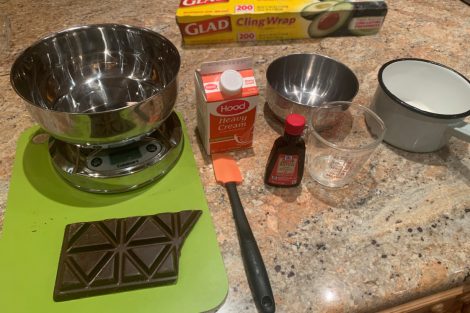
-
Very finely chop the chocolate and place it in a heatproof bowl and set to the side.
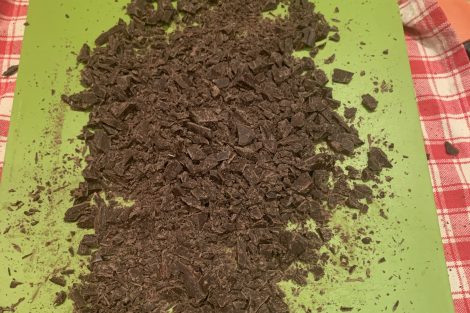
-
Measure out approximately 2/3 of a cup or 160 ml of heavy cream.
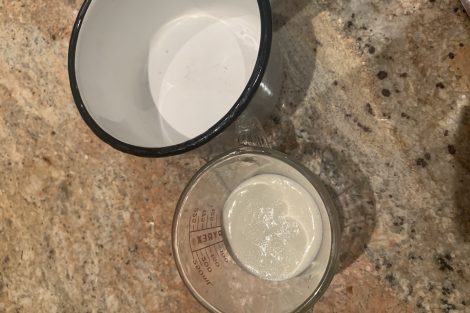
-
Add the heavy cream to a small pot and bring to a simmer. Look for small bubbles around the edges of the pot, once you see those, remove it from the heat Make sure you do not boil the cream, for you will have to start over again.
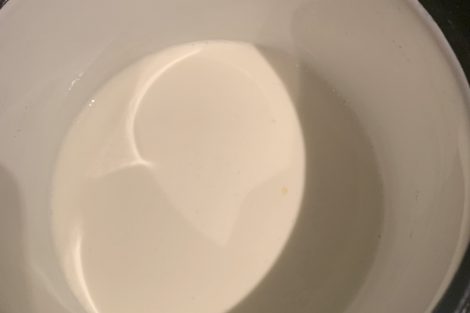
-
Once the heavy cream has started to bubble around the edge, remove it and add it to the heatproof bowl of finely chopped chocolate. At this stage you could add the butter, however, I prefer them without it.
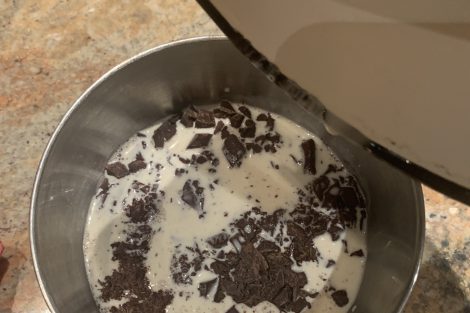
-
After adding the heavy cream to the chocolate, let it sit for approximately five minutes. Now is a great time to clean up the pot and put away the heavy cream.

-
After five minutes, add the vanilla extract and stir until the chocolate is completely melted. Prior to stirring, your mixture should look something like the photo.
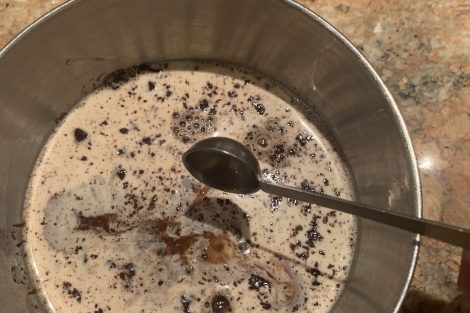
-
After stirring, for a few minutes, typically 2-3, your chocolate should look smooth on top, and have a solid chocolate color. All of the heavy cream should be mixed in using the spatula.
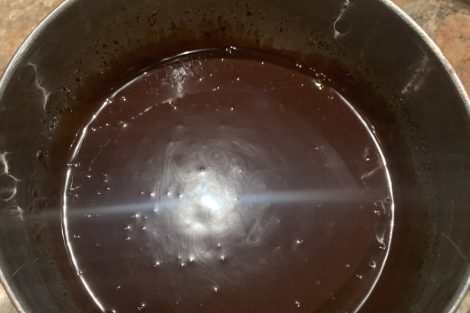
-
Next, place a piece of plastic wrap directly on the surface, to avoid any condensation.
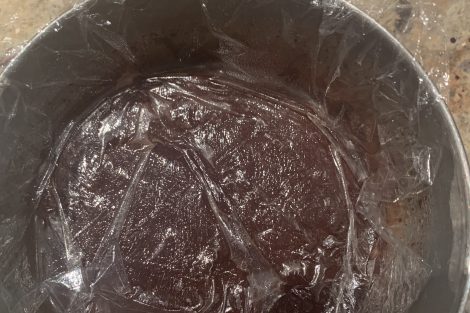
- Place the bowl into the refrigerator and wait 1-2 hours.
-
Lastly, take the bowl out of the refrigerator and remove the plastic wrap. Then, scoop the truffle mix into 2 teaspoon-sized mounds and- Enjoy!
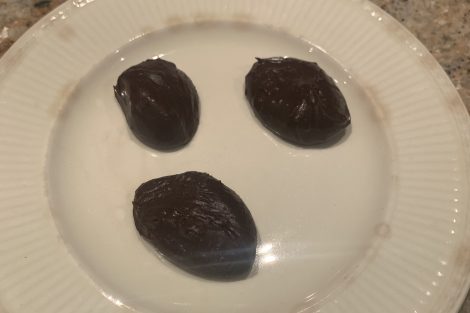
Notes
All of the photos used within this recipe at a glance are my own, for I have taken them during the process of making the truffles.
Original recipe:
S., & Tesee. (2020, March 19). Homemade Chocolate Truffles Recipe. Retrieved May 07, 2020, from https://sallysbakingaddiction.com/homemade-chocolate-truffles/
Works Cited:
Tromba, A. (2019, October 27). All About Vanilla and the (Plausible) Role of Vanilla in Chocolate. Retrieved May 07, 2020, from https://foodensity.com/vanilla-in-chocolate/
LaBau, E. (2020, January 16). How to Fix Melted Chocolate That Suddenly Turns Clumpy. Retrieved May 06, 2020, from https://www.thespruceeats.com/how-to-fix-overheated-or-burnt-chocolate-521579
Provost, J. J. (2016). The science of cooking: understanding the biology and chemistry behind food and cooking. Hoboken, NJ: Wiley.
Stradley, L. (2017, February 20). How to Melt and Temper Chocolate. Retrieved May 06, 2020, from https://whatscookingamerica.net/ChocolateMelting.htm
Quimicadascoisas. (2012, November 23). Retrieved from http://www.aquimicadascoisas.org/en/?episodio=the-chemistry-of-chocolate
Mushet, C., & Caruso, M. (2008). The art and soul of baking. Kansas City, MO: Andrews McMeel Pub.